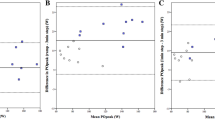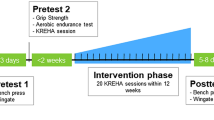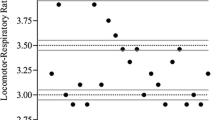Abstract
The aim of this study was to assess the relationship between spontaneously chosen crank rate (SCCR) and power output during two upper body exercise tests: firstly, an incremental maximal aerobic power test (T1), with an initial intensity of 50 W followed by 15-W increases at each subsequent 90-s stage and secondly, a test (T2) with consecutive exercise periods set at 50%, 60%, 70%, 80%, 110% and 120% of maximal power (P max) separated by passive recovery periods. Eight nationally and internationally ranked kayakers, aged 20 (SD 2) years, performed the tests. During both T1 and T2, mean SCCR values were correlated (r = 1) and increased significantly (P < 0.05) in association with the increases in power output. The finding that the subjects consistently increased their crank rate as the power output increased in different tests, i.e. at submaximal, maximal and supramaximal intensities, strongly suggests that SCCR depended on power output and not on the type of exercise (incremental or rectangular exercise). Moreover, the equation relating crank rate and power output determined from T1 suggests that it may be used to predict the crank rate which will be chosen in upper body exercise, whatever the intensity. Finally, the results of testing at 110% and 120% of P max would suggest that a high crank rate (>90 rpm) should be used during the test procedure using supramaximal exercises where accumulated oxygen deficit is calculated, and more particularly when exercise is performed using the upper body.
Similar content being viewed by others
Author information
Authors and Affiliations
Additional information
Accepted: 15 September 1998
Rights and permissions
About this article
Cite this article
Weissland, T., Marais, G., Robin, H. et al. Relationship in humans between spontaneously chosen crank rate and power output during upper body exercise at different levels of intensity. Eur J Appl Physiol 79, 230–236 (1999). https://doi.org/10.1007/s004210050500
Issue Date:
DOI: https://doi.org/10.1007/s004210050500




